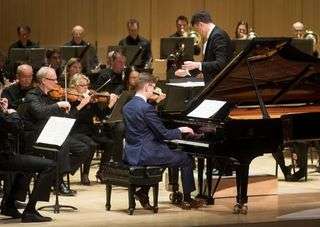|
Back
Muscular modernism Toronto
Roy Thomson Hall
03/03/2018 -
Vivian Fung: Dust Devils
Larry Alan Smith: Symphony No. 4
Daníel Bjarnason: Processions (*)
Víkingur Olafsson (piano)
The Toronto Symphony Orchestra, Peter Oundjian, Daníel Bjarnason (*) (conductors)

V. Olafsson & D. Bjarnason (© Jag Gundu)
The concert opened with Vivian Fung’s Dust Devils. The composer hails from Alberta where she no doubt became acquainted with the fleeting whirlwinds, but the piece refers to emotional swirls in her mind. The 10-minutes work, composed in 2011 and revised in 2014, is a vigorous piece with an expansive, clangorous finale.
American composer Larry Alan Smith’s Symphony No. 4, composed in 2016, has the requisite four movements of the classical symphony - in this case Misterioso e tranquillo - Allegro molto - Cantabile - Con forza. In true developmental fashion, each movement contains episodes that contrast with the opening mood. There is quite the variety of dynamic expression throughout, with big blocks of sound in the third and fourth movements. He uses the 12-tone method - but with more lyrical, tonal results than one usually expects. The overall impression was a hearkening back to, say, Alan Hovhaness. (This does not imply imitating the earlier composer.)
The longest work of the evening was Icelandic composer Daníel Bjarnason’s piano concerto, Processions, composed in 2009 and recorded the following year by Víkingur Olafsson, for whom the work was written. It has three movements: “In Medias Res,” “Spindrift,” “Red-Handed.” In the opening movement the piano has stretches that recall Rachmaninoff, although the orchestration most definitely does not. There are intimate moments when the audience shares the pianist’s intimate communing with his instrument, then it builds to a cataclysmic finish. The second movement begins and ends in meditative mode but in the middle swells up oceanically. “Spindrift” is spray that blows off stormy waves, but there was more storminess in the outer two movements. The final movement features a large array of percussion and the piano joins in with gong-like notes. After a section best described as “frenzied” it melts away with gentle ostinato from the piano.
I am surprised this was its North American premiere - it is a dynamic, even punchy, work.
All three works displayed a lot of personality and confidence.
This concert marked the opening of the TSO’s 14th New Creations Festival. It seems to be also the final such festival. With the departure of Peter Oundjian as TSO Music Director, both it and the Mozart Festival will be ending. New works (and Mozartian works) will appear throughout next season - and it is argued that a larger number of people will hear such pieces, given the normal pattern of two to four repeats of a program vs the single concerts of the festival. And I’m sure it took quite a financial bite as a three-concert pass could be bought for as little as $30. The festival attracted a notably engaged audience - or, I should say an audience desiring to be engaged, as some works failed to ignite a full response (this is bound to happen occasionally). The three works on this program, each displaying character and confidence, were enthusiastically received.
Michael Johnson
|